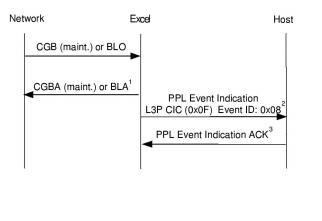
You are here: CSP Developer’s Guide: Common Channel Signaling > 4 SS7 Call Control for ISUP > SS7 CIC Blocking Procedures

When a CIC changes between the out of service (OOS) and in service (INS) states, the SS7 card automatically initiates either a Circuit Blocking/Unblocking or a Circuit Reset for the circuit (or a Group Blocking/Unblocking or Reset if multiple circuits in the same circuit group transition at the same time). The two procedures for changing states are shown below and are controlled by PPL configuration.
Whenever an OOS to INS or the OOS is caused by a non-host initiated request (for example, a purge, or remote ISUP unavailable indication) the SS7 card attempts to send a Circuit Reset (RSC) or a Group Circuit Reset (GRS) (if multiple circuits are in transition at the same time). Also, if the host configures the CIC to send reset upon host-initiated OOS to INS transition, the SS7 card attempts to send a RSC or GRS.
Important! The procedure for initial CIC In Service procedures is consistent with Type B operations as defined in ITU-TS Q.767 Section 4.4.1.
If the host configures the CIC to send blocking upon host initiated INS to OOS transition, the SS7 card attempts to send a Blocking (BLO) or Circuit Group Blocking (CGB) before taking the CIC out of service (this is the default).
When the host brings the CICs back into service, the SS7 card attempts to send an Unblocking (UBL) or Circuit Group Unblocking (CGU) before declaring the circuits as in-service.
For a CIC to start the OOS to INS process, the following three conditions must be met:
• The span on which the CIC resides must be in proper span alignment.
• MTP must consider the DPC as accessible.
• The host must send a Service State Configure message of in-service for the CIC.
When all the conditions are met, the SS7 card attempts to bring the CICs in-service. Upon successful completion of the ISUP Unblocking or Reset procedure, the Excel platform notifies the host by sending a DS0 Status Change message for each CIC, declaring it in-service. You can now use the CICs for calls.
A CIC purge is considered a non host-initiated OOS to INS transition. Because of this, any purge of a CIC initiates an outgoing Circuit Reset.
If the host wants to initiate a Circuit Group Reset (GRS) or Circuit Reset (RSC) it may do so by setting the L3P CIC PPL configuration byte 10 and then cycling the CICs OOS first and next INS through the use of the Service State Configure message. The host-initiated OOS to INS transition forces an outgoing GRS or RSC. This action is taken to force a reset of the entire Excel platform call processing stack, not just the ISUP portion of it.
A PPL Event Request message cannot generate an RSC or GRS. If a CIC is taken OOS from the host through the use of the Service State Configure message, the CIC is blocked if configured to do so and marked as Unequipped by ISUP. Any messages from the DPC are treated as messages for an Unequipped Circuit.
If a CIC circuit group is in service and a span alarm is detected, a Circuit Group Blocking message is automatically sent (or Circuit Group Hardware Blocking for ITU) for the concerned circuit group. The host receives a DS0 Status Change message indicating that all of the channels in the circuit group are OOS.
If a call was active, the CIC purges with the reason Span Status Dead (0x03). Upon return of proper span framing, a Circuit Group Unblocking is automatically sent (or Circuit Group Hardware Unblocking for ITU) for the concerned circuit group. Upon successful unblocking of the circuit group, the host receives DS0 Status Change messages of INS.
Important! The circuits that purged because of span failure do not send Circuit Resets in this case because they are included in the Circuit Group Unblocking from the span alarm.
All CICs related to the DPC in question are taken OOS and no blocking messages are sent if the MTP declares one of the following:
• DPC Inaccessible
• Remote ISUP Unavailable
• MTP Pause
In either case, a General alarm of SS7 Remote ISUP Unavailable (0x0F) is sent to the host.
Circuit Maintenance and Management Call Flows
Some messages in these call flows are numbered. The numbered messages are described in more detail beside the corresponding number following each call flow.

1. The Excel platform automatically sends the DPC the proper CGBA or BLA.
2. The Excel platform alerts the host when an incoming Maintenance Blocking Request is made by sending a PPL Event Indication message for every channel blocked by the DPC. The PPL Event Indication has an SS7 parameters ICB that contains the data of either the incoming CGB or BLO.
3. Upon receiving this message, the host should not send outgoing calls on this channel until the blocking is cleared by the DPC. The DPC may send an incoming call on the blocked channel, however. In this event, the host receives a PPL Event Indication of Maintenance Unblocking (without an SS7 parameters ICB) followed by a Request for Service message for the incoming call. The host must acknowledge the PPL Event Indication message.
4. The host must acknowledge the PPL Event Indication message.
Incoming Maintenance Unblocking
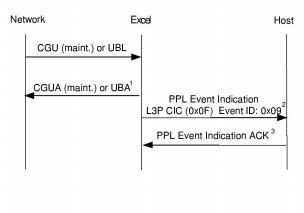
1. The Excel platform automatically sends the proper CGUA or UBL to the DPC.
2. The Excel platform alerts the host when an incoming Maintenance Unblocking Request with a PPL Event Indication message for every channel unblocked by the DPC. The PPL Event Indication has an SS7 parameters ICB containing the data of either the incoming CGU or UBL.
3. Upon receiving this message, the host can make the channel available for outgoing calls. There may be instances in which no SS7 Parameter ICB is included in the PPL Event Indication message.
4. The host must acknowledge the PPL Event Indication.
Incoming Hardware Failure Oriented Blocking (ITU only)
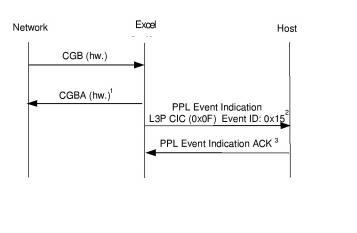
1. The Excel platform automatically sends the DPC the proper CGBA.
2. The Excel platform alerts the host when an incoming Hardware Failure Oriented Blocking Request with a PPL Event Indication message for every channel blocked by the DPC. The PPL Event Indication message includes an SS7 parameters ICB containing the data of the incoming CGB.
3. Upon receiving this message, the host should not send outgoing calls on these channels until the blocking is cleared by the DPC. The DPC may send an incoming call on the blocked channels, however, upon which, the host will receive a Maintenance Unblocking PPL Event Indication (without an SS7 parameters ICB) followed by a Request for Service message for the incoming call.
4. The host must acknowledge the PPL Event Indication message.
Incoming Hardware Failure Oriented Unblocking (ITU only)
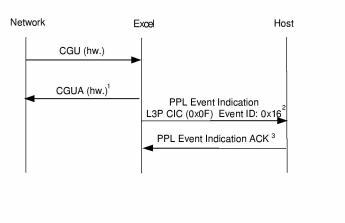
1. The Excel platform automatically sends the DPC the proper CGUA.
2. The Excel platform alerts the host when an incoming Hardware Failure Oriented Unblocking Request is made with a PPL Event Indication message for every channel blocked by the DPC. The PPL Event Indication will include an SS7 parameters ICB containing the data of the incoming CGU.
3. Upon receiving this, the host can now make the channels available for outgoing calls. There may be instances in which no SS7 Parameter ICB is attached to the PPL Event Indication. See Incoming Hardware Failure Oriented Blocking (ITU only).
4. The host must acknowledge the PPL Event Indication message.
Outgoing Maintenance Blocking Request
By default, the host cannot generate Hardware Failure Oriented Blocking with the PPL Event Request message. Hardware Failure Blocking is automatically generated in the event of a loss of signal on the span that carries the CIC. Unblocking is automatic when spans align.
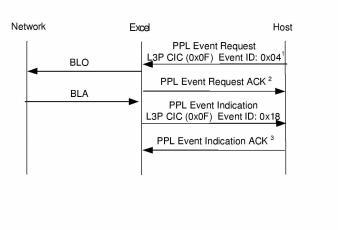
1. The host sends a PPL Event Request message to request Local Maintenance Blocking for a CIC. The message can contain an SS7 parameter ICB with parameters for the outgoing BLO message.
2. The Excel platform will acknowledge the PPL Event Request.
3. Upon successful completion of the maintenance blocking procedure, the Excel platform alerts the host by sending a PPL Event Indication message. The PPL Event Indication will include an SS7 Parameters ICB containing parameters from the BLA. The host should not initiate any outgoing call without first sending a PPL Event Request message of Maintenance Unblock.
4. The host must ACK the PPL Event Indication.
Outgoing Maintenance Unblocking Request
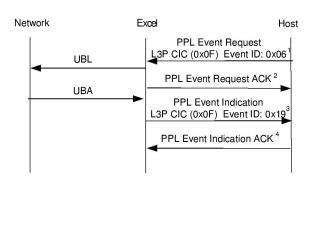
1. The host sends a PPL Event Request message to request Local Maintenance Unblocking for a CIC. The event request can contain an SS7 Parameter ICB with parameters for the outgoing UBL message.
2. The Excel platform acknowledges the PPL Event Request.
3. Upon successful completion of the Maintenance Unblocking procedure, the Excel platform alerts the host by sending a PPL Event Indication message, which contains an SS7 Parameters ICB containing the parameters from the UBA. The host can now initiate outgoing calls.
4. The host must ACK the PPL Event Indication message.
Outgoing Maintenance Group Blocking Request
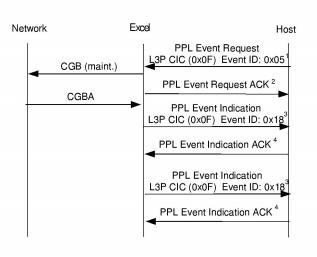
1. The host sends a PPL Event Request message to request Local Maintenance Group Blocking for a CIC circuit group. The event request can contain an SS7 Parameter ICB with parameters for the outgoing CGB message.
2. The Excel platform acknowledges the PPL Event Request message.
3. Upon successful completion of the Maintenance Group Blocking procedure, the Excel platform alerts the host by sending a PPL Event Indication message for each CIC. The PPL Event Indication contains an SS7 Parameters ICB, which contains the parameters from the CGBA. The host should not initiate any non-test outgoing call without first sending a Maintenance Unblock PPL Event Request message for the channel(s).
4. The host must ACK each PPL Event Indication message.
Important! By default, the host cannot generate hardware failure oriented blocking with the PPL Event Request message. Hardware Failure Oriented Blocking is automatically generated in the event of a loss of signal on the span that carries the CIC. Unblocking is automatic when the span aligns.
Outgoing Maintenance Group Unblocking Request

1. The host sends a PPL Event Request message to request Local Maintenance Group Unblocking for a CIC circuit group. The event request can contain an SS7 Parameter ICB with parameters for the outgoing CGU message.
2. The Excel platform acknowledges the PPL Event Request message.
3. Upon successful completion of the Maintenance Group Unblocking procedure, the Excel platform alerts the host by sending a PPL Event Indication message for each CIC. The PPL Event Indication contains an SS7 Parameters ICB containing the parameters from the CGU. The host can now initiate outgoing calls.
4. The host must ACK each PPL Event Indication message.
Local Circuit Maintenance Unblocking Indication

1. The Excel platform alerts the host when the Local Maintenance Blocking state is cleared. This is typically done when an ISUP component has requested that the CIC be reset (for example, receipt of Unreasonable Signaling to an idle ISUP CPC). The host now considers the channel as not Locally Maintenance Blocked. The host can re-establish blocking. See "Outgoing Maintenance Group Blocking Request."
2. The host must ACK each PPL Event Indication message.